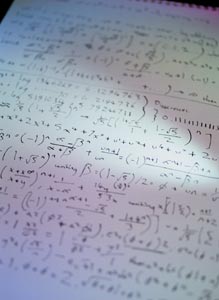While writing A Brief History of Time Stephen Hawking was told that each equation he included in the book would halve the sales. After resolving not to include any equations, Hawking decided to make an exception for E = mc2, and went on to sell millions of books. Physics World tries to keep equations to a minimum, and to maximize reader numbers as well, but this issue is an exception. On pages 14 to 15 Robert Crease reports on the results of his poll to find "the greatest equations ever". Although the exercise cannot be described as rigorous or comprehensive, more than 100 readers responded, and for once Einstein didn't win.
Some 20 equations received two or more nominations, but two very different equations were clearly considered greater than the rest — Maxwell’s equations of electromagnetism and the Euler equation. While the latter is a construction of truly bewildering beauty and simplicity, eiπ+ 1 = 0, its relation to the physical world is not obvious.
Maxwell’s equations, on the other hand, inspired many of the great theories of the 20th century, as well as putting electricity, magnetism and optics on a solid theoretical basis for the first time. Among other things, Maxwell used his four equations — which first took shape in the 1850s and appeared in their final form in 1873 — to calculate the speed of light and predict the existence of electromagnetic waves at non-visible wavelengths.
Describing Maxwell’s equations, Heinrich Hertz once said, “One cannot escape the feeling that…they have an intelligence of their own, that they are wiser than we are, wiser even than their discoverers, that we get more out of them than was originally put into them.” And so it was that Einstein combined Maxwell’s equations with the principle of relativity to derive E = mc2. And later, in 1927, Dirac applied quantum theory to them and went on to formulate his equation for the electron and lay down the foundations of quantum electrodynamics.
Maxwell’s equations also possess another subtle property — local gauge invariance — although the significance of this was not realized until Chen-Ning (Frank) Yang and Robert Mills published a ground-breaking paper on the strong force 50 years ago this month (1954 Phys. Rev. 96 191). Local gauge invariance is now known to be an essential feature of both the strong and electroweak interactions, and Yang-Mills equations are used to describe both of these forces in the Standard Model of particle physics.
In simple terms, gauge invariance or symmetry means that something — for example, the electric potential in electromagnetism — can be “re-gauged” or changed without having a noticeable effect. Local gauge invariance means that the electric potential can be changed by different amounts at different places in space and time without changing Maxwell’s equations. Indeed, some theorists speculate that the fundamental forces are nature’s way of maintaining local gauge symmetries in the world. For some reason — perhaps because it cannot be written on a T-shirt, or because gauge invariance is such a subtle concept — the Yang-Mills equation is absent from our list of great equations.
Although Hawking caused a stir when he wrote about “knowing the mind of God” at the end of A Brief History of Time, Steven Weinberg managed to escape similar controversy when he brought equations and religion together in an essay published in It Must Be Beautiful (a collection of articles about great equations that includes a chapter on the Yang-Mills equation by Christine Sutton). Weinberg compares the great equations of modern physics to cathedrals, and concludes that “they might outlast even the beautiful cathedrals of earlier ages”. Of course, as Weinberg points out, all equations in physics are approximations, but the very best will remain useful for as long as time itself.




